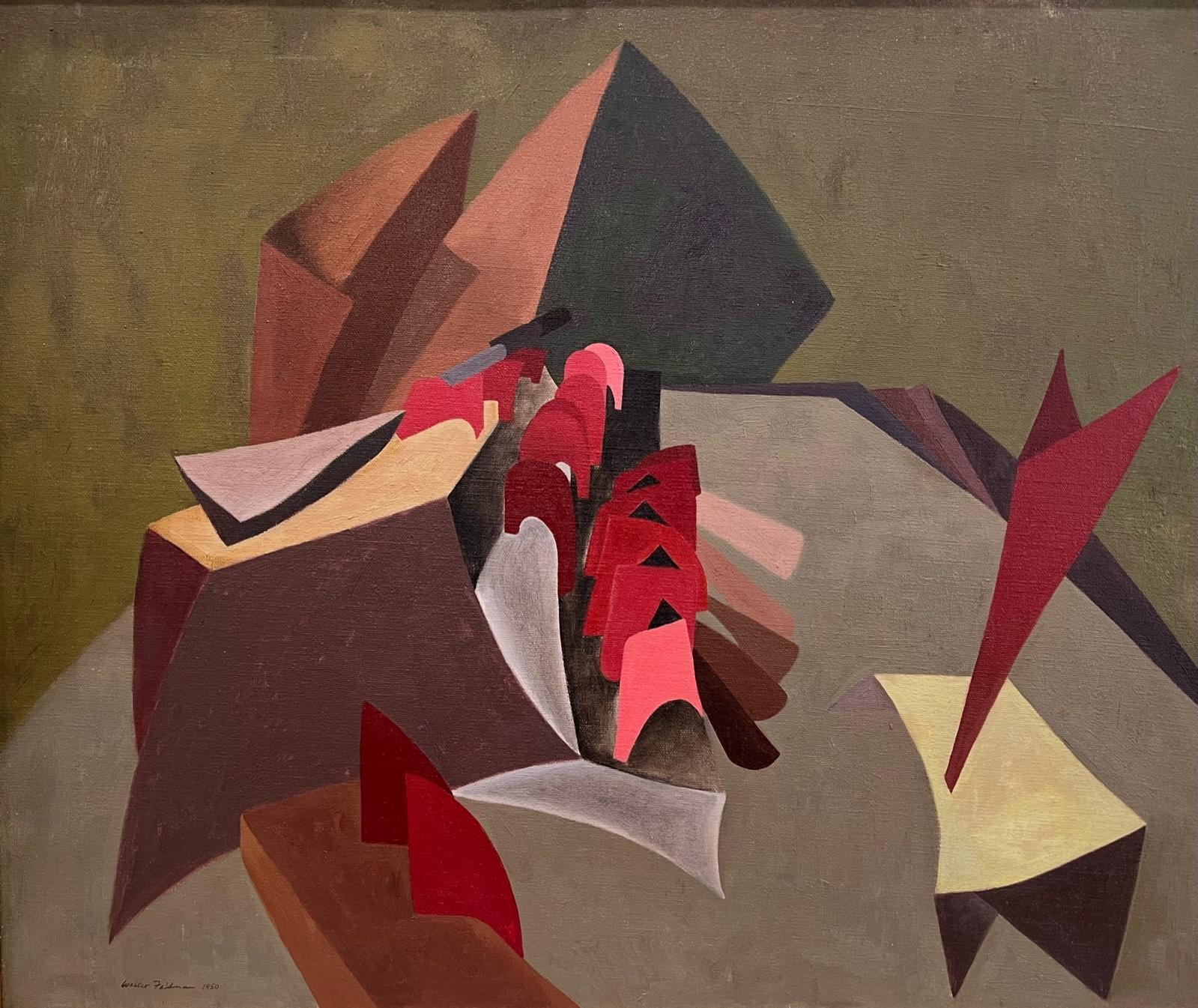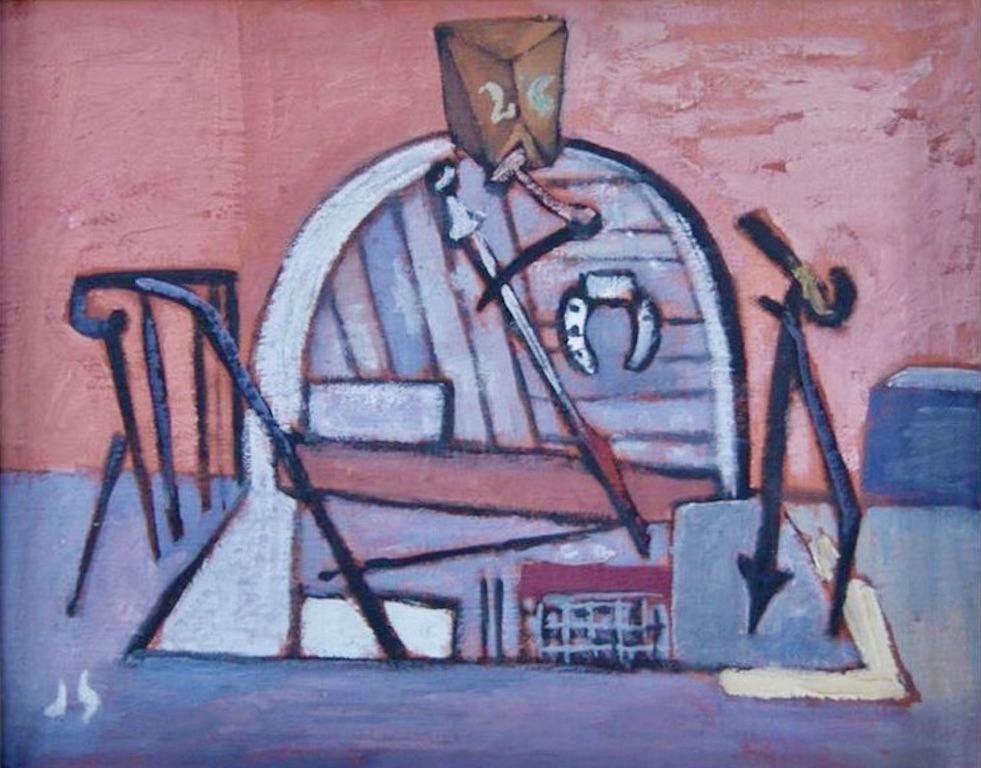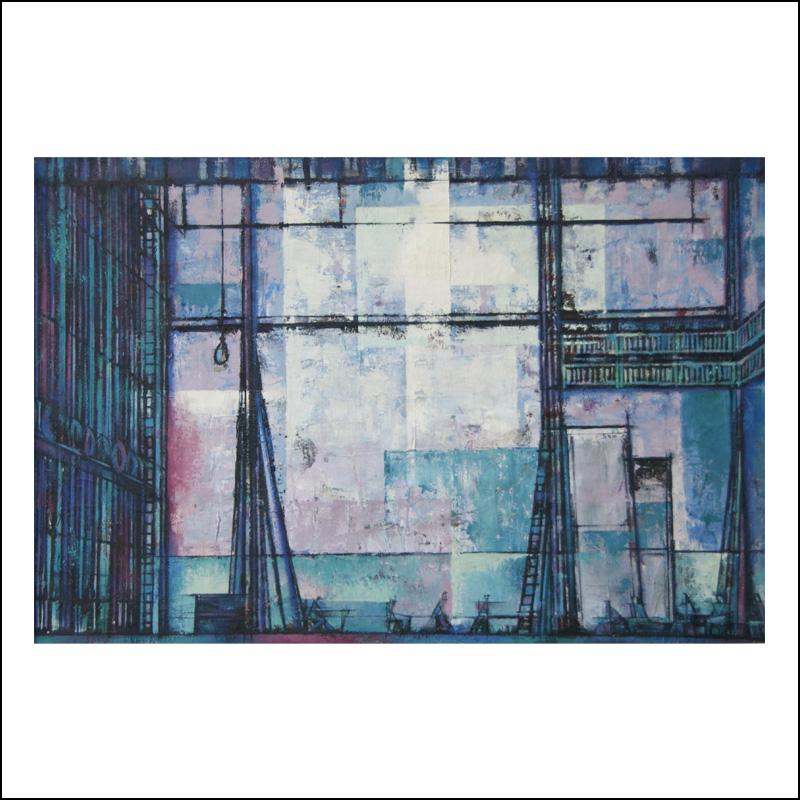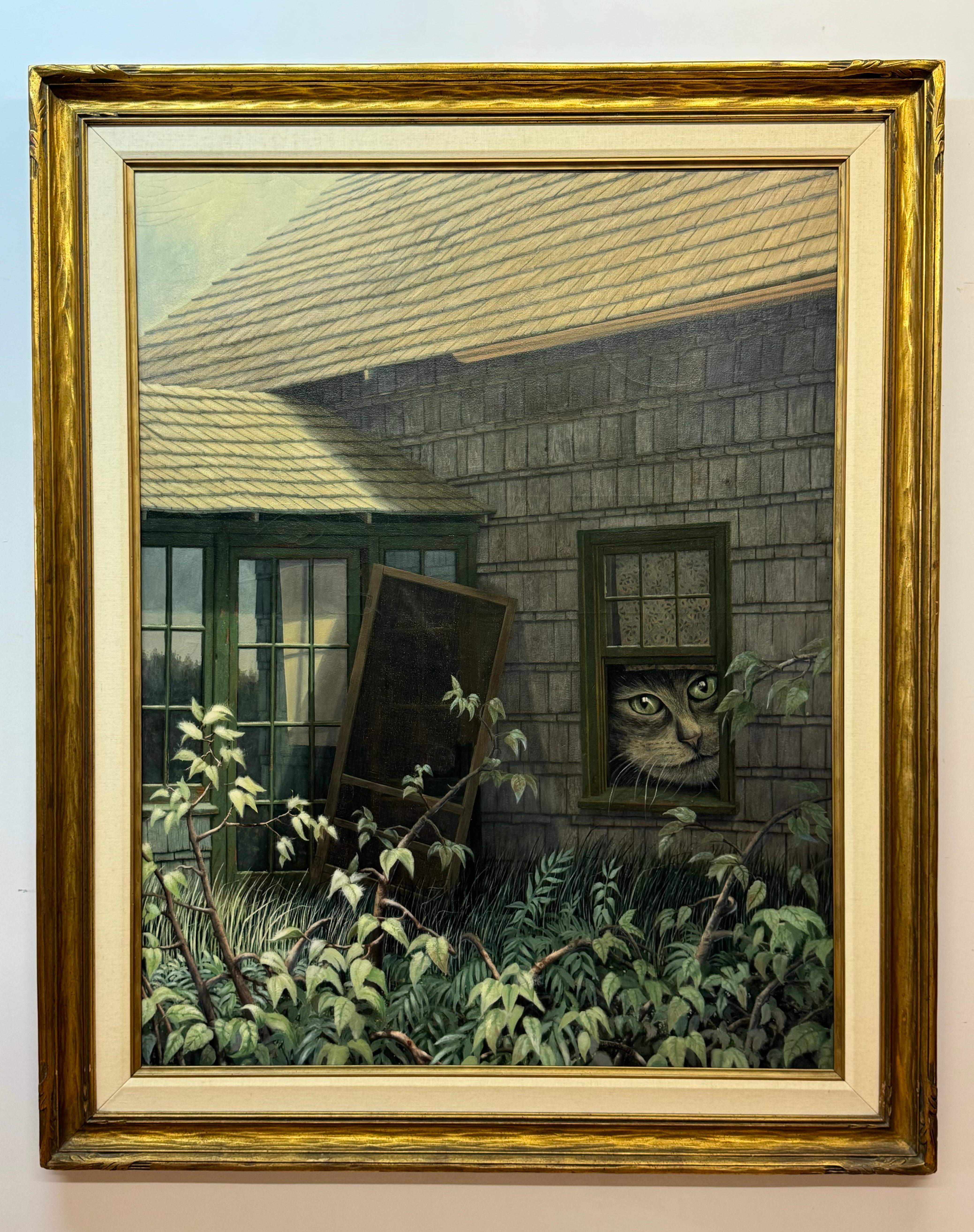Items Similar to Interieur No. II
Want more images or videos?
Request additional images or videos from the seller
1 of 15
Benjamin G. BennoInterieur No. II1937
1937
About the Item
Interieur No. II
Oil on canvas, 1937
Signed on verso (see photo)
nscribed on reverse:
Benno 1937
"Interieur" (No. II)
35 x 27 cm
9 rue Compagne Premiere
Paris 14e
Provenance: Estate of the artist
Ruth O'Hara, Lang & O'Hara, New York
Jem Hom Fine Art, Washington & New York
Canvas size: 13 3/4 x 10 3/4 inches
Frame: 18 1/2" x 15 1/4" x 1 3/4 inches
This painting was created in Paris in 1937. During this time, Picasso was Benno's friend and mentor. It was Picasso who gave Benno the necessary money to leave Paris as the Nazi's invaded and started rounding up the Jews for extermination.
This painting is signed and inscribed on the verso (see photo)
It was exhibited at:
Benjamin Benno: A Retropsective Exhibition, Zimmerli Art Museum, 1988
This painting is illustrated and sited on page 19 of the catalog (see photo).
A copy of the catalog accompanies the painting.
Exhibitions:
New Brunswick, NJ, Jane Voorhees Zimmerli Art Museum, September 11- November 20, 1988: "Benjamin Benno: A Retrospective Exhibition," , No. 55
Bibliography:
Donna Gustafson, Benjamin Benno (New Brunswick, NJ; Jane Voorhees Zimmerli Art Museum, 1988), reproduced p. 19
Benjamin Benno was regarded as a child prodigy. In 1912 his formal training began with Robert Henri and George Bellows in New York. He studied at the progressive Ferrer School known for its emphasis on freethinking and association with the anarchist movement. For eight years he traveled throughout the world painting and gaining confidence in his art.
Financed by collectors, Benno moved to Paris in 1926. He briefly returned to New York in 1931 and upon receiving a Guggenheim Fellowship immediately returned to Paris where he remained until 1939. By the early 1930s he had established a reputation as a member of the international avant-garde and exhibited with the most significant European artists including Paul Klee, Max Ernst, Wassily Kandinsky, Salvador Dalí, Joan Miró, Hans Arp, and Fernand Léger. Pablo Picasso sponsored Benno's first one-man show in Paris in 1934.
With the outbreak of war in 1939, Benno returned to New York along with many artist exiles. In America, his eccentric nature and experimental paintings were received harshly by critics. Enraged by this reception, Benno became bitter and hostile. Galleries and museums were disturbed by his temperament and Benno’s presence in the art world waned.
Benno spent his last years buying back his works and preparing his papers for posterity. The paintings in this exhibition exemplify a man passionately committed to his art and convinced of his place in history.
This exhibition features major works from the 1930s when Benno was living in Paris and regarded as a distinguished member of the cultural avant-garde.During this time, Benno became acutely aware of the Modernists and reflected various avant-garde movements in his work. The principles of Surrealism, Cubism and Constructivisim influenced Benno, yet his strong personality imbued his art with a distinctive quality.
Courtesy Michael Rosenfeld Gallery
- Creator:Benjamin G. Benno (1901-1980, American)
- Creation Year:1937
- Dimensions:Height: 13.75 in (34.93 cm)Width: 10.75 in (27.31 cm)
- Medium:
- Movement & Style:
- Period:
- Condition:Original condition.
- Gallery Location:Fairlawn, OH
- Reference Number:
About the Seller
5.0
Recognized Seller
These prestigious sellers are industry leaders and represent the highest echelon for item quality and design.
Platinum Seller
These expertly vetted sellers are 1stDibs' most experienced sellers and are rated highest by our customers.
Established in 1978
1stDibs seller since 2013
711 sales on 1stDibs
Typical response time: 1 hour
Associations
International Fine Print Dealers Association
- ShippingRetrieving quote...Ships From: Fairlawn , OH
- Return PolicyA return for this item may be initiated within 10 days of delivery.
More From This SellerView All
- #90 Strange CreatureBy Norbert LenzLocated in Fairlawn, OH#90 Strange Creature Oil and pencil on board, 1932 Signed and dated in the image lower right (see photo) Provenance: Joseph M. Erdelac, Cleveland, OH Condition: excellent Archival framing Image size: 10 1/2 x 11 3/4 inches Frame size: 25 x 24 inches Painter, illustrator and commercial artist Norbert Lenz was born in Norwalk, Ohio and received his artistic training at both the Huntington Polytechnic Institute and the Cleveland School of Art. During his career Lenz exhibited his paintings and drawings at such institutions as the Pennsylvania Academy of Fine Art, the Art Institute of Chicago, the Cleveland Museum of Art and the Butler Institute of American Art. Today the art of Norbert Lenz is held by the Columbus Museum of Art, the Cleveland Museum of Art and the Butler Institute of American Art. Lenz was also a very highly regarded commercial designer of stamps. He worked for a number of years at the House of Farman, a leading vendor of first day covers...Category
1930s American Modern Abstract Paintings
MaterialsOil
- Study for Mid-Manhattan IIBy John MarinLocated in Fairlawn, OHStudy for Mid-Manhattan II Oil and graphite on paper, mounted to board, 1932 Signed by the artist in pencil lower right Sight size: 8 1/2 x 7 inches One of a series of studies for th...Category
1930s American Modern Abstract Paintings
MaterialsOil
- PersephoneBy Virginia DehnLocated in Fairlawn, OHPersephone Oil on canvas, 1952 Signed lower left (see photo) Titled reverse "Persephone" Signed "V. 52" Exhibited: Columbus Gallery of the Arts label "71/30 Bt. 2", see label Condi...Category
1950s American Modern Abstract Paintings
MaterialsAcrylic
- Arctic Light - Orange SunBy Karl ZerbeLocated in Fairlawn, OHArctic Light-Orange Sun Unsigned Gouache on Japanese fibrous paper Series: Tundra Paintings Exhibited: Karl Zerbe, Gouaches of the Artic Nordness Gallery, (Madison Avenue, NY) Feb 3 through Feb 23, 1958 Cat. No. 12 (label with work, see photo...Category
1950s American Modern Abstract Paintings
MaterialsGouache
- PersephoneBy Virginia DehnLocated in Fairlawn, OHPersephone Oil on canvas, 1952 Signed lower left (see photo) Titled reverse "Persephone" Signed "V. 52" Exhibited: Columbus Gallery of the Arts label "71/30 Bt. 2", see label Condition: two very small flakes of missing paint Canvas size: 20 1/8 x 16" Frame size: 20 7/8 x 16 3/4" Provenance: Estate of the artist Dehn Heirs An important painting by the artist. Virginia Dehn From Wikipedia, the free encyclopedia Virginia Dehn (1922-2005) Virginia Dehn (née Engleman) (October 26, 1922 – July 28, 2005) was an American painter and printmaker. Her work was known for its interpretation of natural themes in almost abstract forms. She exhibited in shows and galleries throughout the U.S. Her paintings are included in many public collections. Life Dehn was born in Nevada, Missouri on October 26, 1922.] Raised in Hamden, Connecticut, she studied at Stephens College in Columbia, Missouri before moving to New York City. She met the artist Adolf Dehn while working at the Art Students League. They married in November 1947. The two artists worked side by side for many years, part of a group of artists who influenced the history of 20th century American art. Their Chelsea brownstone was a place where artists, writers, and intellectuals often gathered. Early career Virginia Dehn studied art at Stephens College in Missouri before continuing her art education at the Traphagen School of Design, and, later, the Art Students League, both located in New York City. In the mid-1940s while working at the Associated American Artists gallery, she met lithographer and watercolorist Adolf Dehn. Adolf was older than Virginia, and he already enjoyed a successful career as an artist. The two were married in 1947 in a private ceremony at Virginia's parents house in Wallingford, Connecticut. Virginia and Adolf Dehn The Dehns lived in a Chelsea brownstone on West 21st Street where they worked side by side. They often hosted gatherings of other influential artists and intellectuals of the 20th century. Among their closest friends were sculptor Federico Castellón and his wife Hilda; writer Sidney Alexander and his wife Frances; artists Sally and Milton Avery; Ferol and Bill Smith, also an artist; and Lily and Georges Schreiber, an artist and writer. Bob Steed and his wife Gittel, an anthropologist, were also good friends of the Dehns. According to friend Gretchen Marple Pracht, "Virginia was a glamorous and sophisticated hostess who welcomed visitors to their home and always invited a diverse crowd of guests..." Despite their active social life, the two were disciplined artists, working at their easels nearly daily and taking Saturdays to visit galleries and view new work. The Dehns made annual trips to France to work on lithographs at the Atelier Desjobert in Paris. Virginia used a bamboo pen to draw directly on the stone for her lithographs, which often depicted trees or still lifes. The Dehns' other travels included visits to Key West, Colorado, Mexico, and countries such as Greece, Haiti, Afghanistan, and India. Dehn's style of art differend greatly from that of her husband, though the two sometimes exhibited together. A friend of the couple remarked, "Adolf paints landscapes; Virginia paints inscapes." Virginia Dehn generally painted an interior vision based on her feelings for a subject, rather than a literal rendition of it.] Many of her paintings consist of several layers, with earlier layers showing through. She found inspiration in the Abstract Expressionism movement that dominated the New York and Paris art scenes in the 1950s. Some of her favorite artists included Adolf Gottileb, Rothko, William Baziotes, Pomodoro, and Antonio Tapies. Dehn most often worked with bold, vibrant colors in large formats. Her subjects were not literal, but intuitive. She learned new techniques of lithography from her husband Adolf, and did her own prints. Texture was very important to her in her work. Her art was influenced by a variety of sources. In the late 1960s she came across a book that included photographs of organic patterns of life as revealed under a microscope. These images inspired her to change the direction of some of her paintings. Other influences on Dehn's art came from ancient and traditional arts of various cultures throughout the world, including Persian miniatures, illuminated manuscripts, Dutch still life painting, Asian art, ancient Egyptian artifacts...Category
1950s American Modern Abstract Paintings
MaterialsAcrylic
- UntitledBy Peter MarksLocated in Fairlawn, OHUnsigned Provenance: Estate of the artist Peter Marks (1935 -2010) Peter Marks was born in New York City on January 18, 1935. A lifetime New Yorker, Marks graduated from the High...Category
21st Century and Contemporary Abstract Abstract Paintings
MaterialsOil
You May Also Like
- The OrchestraLocated in Los Angeles, CAThe Orchestra, 1950, oil on canvas, 21 ½ x 25 3/4 inches, signed and dated lower left, labeled verso “Brown University, Trustee, The Walter Feldman Trus...Category
Mid-20th Century American Modern Abstract Paintings
MaterialsCanvas, Oil
- Amish Farmscape #3By Edmund LewandowskiLocated in Los Angeles, CAAmish Farmscape #3, 1984, oil on canvas, 40 x 30 inches, signed and dated lower right; signed, dated, and titled verso About the Painting Amish Farmscape #3 is part of a multi-painting series of barns completed in the early 1980s for an exhibition at New York’s prestigious Sid Deutsch Gallery. Lewandowski painted this work at an important point in his career. It was the first major project undertaken by Lewandowski after his retirement from serving as the Chairman of Winthrop University’s Art Department, the last academic position he held after teaching for nearly thirty years. Lewandowski had been inspired to work on the series by a visit to Lancaster County, Pennsylvania. Like his friend and mentor, Charles Sheeler, Lewandowski had always been fascinated by vernacular architecture and the Amish barns of Pennsylvania brought back memories of rural scenes Lewandowski had painted in the Midwest much earlier in his career. Amish Farmscape #3 is a strong example of Lewandowski’s late precisionist work. The complexity of the composition and Lewandowski’s technical acumen are on full display. Being relieved of the burdens of teaching and administering a university art department likely allowed Lewandowski greater freedom and most importantly more time to complete the Amish Farmscape series. Although Lewandowski’s brand of precisionism changed throughout the years, he never deviated from the core tenets of the Immaculate School artists. In this work, we see simplified and flattened forms, the use of ray-lines to define light and space, the elimination of extraneous details, a polished almost machine-like finish, and the complete lack of visible brushstrokes, all hallmarks of the precisionist painters. Lewandowski was the last of the 20th century precisionists and in Amish Farmscape #3, we see just how successfully he continued to work in this style until his death in 1998. About the Artist Edmund Lewandowski was among the best of the second-generation precisionist painters. He was born and raised in Milwaukee, Wisconsin and studied at the Layton School of Art with Garrett Sinclair. Lewandowski achieved early success when in 1936 two of his watercolors were shown at the Phillips Collection as part of a Federal Art Project exhibition. Then, in 1937, his work was first exhibited at Edith Halpert’s Downtown Gallery which represented Lewandowski into the 1950s. Under Halpert’s guidance, Lewandowski continued to explore watercolor as his main medium during the 1930s and 1940s, since the gallery already represented Charles Sheeler, who worked primarily in oils. Sheeler became Lewandowski’s major influence as the primary leader of the ill-defined, but very recognizable Immaculate School artists, which included other Downtown Gallery painters, Niles Spencer, George Ault, and Ralston Crawford, as well as Charles Demuth and Preston Dickinson, both of whom died at a young age and had been represented by the Charles Daniel Gallery. Sheeler is credited with giving Lewandowski technical advice on how to make his paintings more precise and tightly rendered and by all accounts, Sheeler was a fan of Lewandowski’s work. Through the Downtown Gallery, Lewandowski’s paintings were accepted into major national and international exhibitions and purchased by significant museums and collectors. Franklin and Eleanor Roosevelt and Nelson Rockefeller acquired works by Lewandowski. He was included in the Museum of Modern Art’s important 1943 exhibition, American Realists and Magic Realists as well as juried exhibitions at the Whitney Museum of American Art, the Pennsylvania Academy of Fine Arts, and the Art Institute of Chicago. Lewandowski also completed commissions for magazines during the 1940s and 1950s, including several covers for Fortune. Throughout his career, Lewandowski explored urban and rural architecture, industry, machinery, and nautical themes. Looking back on his career, Lewandowski wrote, “My overwhelming desire as an artist through the years has been to record the beauty of man-made objects and energy of American industry on canvas. For as far back as I can recall, the cityscapes, farms and depictions of industrial power and technological efficiency has had a great attraction for me. I try to treat these observations with personal honesty and distill these impressions to a visual order.” Lewandowski is credited with extending precisionism to the Midwest and successfully continuing the style into the 1990s, three decades after Sheeler’s death and six decades after Demuth’s passing. Late in his career, Lewandowski enjoyed a resurgence of popularity as he was represented during the 1980s by New York’s Sid Deutsch and Allison Galleries...Category
Mid-20th Century American Modern Landscape Paintings
MaterialsCanvas, Oil
- WPA American Scene Modernism 20th Century NYC Industrial "Cellar with Horseshoe"By Joseph SolmanLocated in New York, NY"Cellar with Horseshoe" WPA American Scene Modernism 20th Century NYC Industrial Joseph Solman (1909-2008) "Cellar with Horseshoe," 16 x 20 inches, oil on canvas circa 1938, initial...Category
1930s American Modern Landscape Paintings
MaterialsCanvas, Oil
- "Backstage, Ambassador" Broadway Theatre NYC Mid-century Modern Modernist CubistBy Sam NorkinLocated in New York, NY"Backstage, Ambassador" Broadway Theatre NYC Mid-century Modern Modernist CubistSigned lower left, titled on the stretcher. Norkin was a Brooklyn, Ne...Category
1940s American Modern Interior Paintings
MaterialsCanvas, Oil
- "Shattered" WPA Mid 20th Century Modernism American Scene Surrealism FigurativeBy Leon BibelLocated in New York, NY"Shattered" WPA Mid 20th Century Modernism American Scene Surrealism Figurative Estate stamp on the stretcher, verso. Provenance: Estate of the artist. 20 x 24 inches. BIO Leon Bibel continued painting through 1941 and resumed work in both painting and especially wood sculpture by 1960. He worked until his very last day in 1995. His last series of large wood sculptures were modeled on spice boxes, which were miniature buildings...Category
1930s American Modern Figurative Paintings
MaterialsCanvas, Oil
- R. Hoag “Large Cat Peering Out Window”Located in San Francisco, CAOil on canvas 1979 Large cat peering out window Framed 45.25x55.5 Unframed 36x47Category
1960s American Modern Abstract Paintings
MaterialsCanvas, Oil




